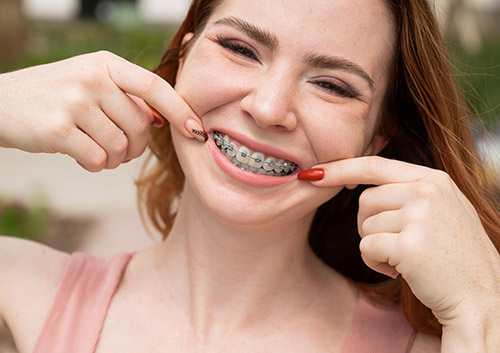
We’re not talking about tearing up at the end of a sad movie, or that uncomfortable scratchy feeling you get from a coarse wool sweater—no shame in that kind of sensitivity! But it is a shame if you’re feeling unpleasant tooth sensitivity, especially while you’re wearing braces. No fear—we have some helpful ideas to make you more comfortable as you create your healthy, confident smile.
What do we mean by tooth sensitivity? You know it if you’ve felt it. Pain when you have a cold drink. Or a hot one. Or a sweet treat. Wincing when a light breeze hits your smile. Discomfort after an adjustment.
Fortunately, these annoying twinges can be avoided or eased with some proactive practices.
Keep Up with Your Brushing and Flossing
The oral bacteria in plaque break down enamel when they’re left on the teeth for too long. The result is a cavity, which leaves your sensitive dentin, the layer of the tooth between the enamel and the inner pulp chamber, exposed to elements which can trigger pain. These all-too-common elements include heat, cold, air, or sweet foods. If you suspect you have a cavity, a visit to the dentist will make sure your tooth is cleaned and filled to prevent further damage.
Better yet, prevent cavities before they cause tooth sensitivity. It can be harder to keep your teeth their cleanest while you’re in braces, but it’s more important than ever. You don’t want to have brackets and wires removed, even temporarily, to treat a cavity! You can keep decay at bay by:
Avoid Aggressive Brushing
If you’re using anything other than a soft toothbrush, time for a shopping trip! Using a stiff bristled brush is almost always too abrasive for even the strongest enamel. And vigorous brushing is more harmful than helpful. Poor tools and poor technique can wear away enamel, and, when enamel is worn away, the more sensitive dentin is exposed. Your gums can also be injured, exposing the tops of your roots—which are more sensitive than the enameled crowns.
If your teeth are sensitive because of abrasive brushing, talk to Dr. Peter Keenan about possible solutions for keeping your teeth both clean and strong.
Care for Yourself after Adjustments
Your teeth might be sensitive after an adjustment. This discomfort is normal, and should pass in a few days. In the meantime, treat yourself kindly.
Be sensitive to your needs while you’re in braces. If you’re feeling any kind of tooth sensitivity, talk to Dr. Peter Keenan at our Galway or Castlebar office. We have solutions which will make sure you’re both comfortable and twinge-free on your journey to a healthy, attractive smile!

Some experiences are great, and we look forward to enjoying them again and again. Others have wonderful outcomes, but you feel no need for a sequel. If you’re wondering whether you need to revisit orthodontic treatment, you’re probably in this second group.
After all, you put in your time as a teenager. All those days in bands and braces, all the adjustments, all that cleaning with little tiny tools in little tiny places. That was a lot of work, and you reaped the rewards of your conscientious orthodontic habits with beautifully aligned teeth and a healthy, comfortable bite.
But now you’ve started to notice that your teeth aren’t quite as beautifully aligned, or your bite’s not quite as comfortable. So, what’s happened? Let’s look at some possibilities, and whether a return to the orthodontist’s office is in order.
If you’ve lost a tooth because of injury or decay, that gap is an open invitation for surrounding teeth to move in to fill the void. Whenever you lose a tooth, consider an implant. Implants function, look, and maintain healthy spacing just like natural teeth.
One thing implants can’t do? Move like our own teeth will during orthodontic treatment. Your natural teeth can move because they are held in place within the bone by flexible periodontal ligaments. Implants, on the other hand, are anchored directly to the bone for stability.
If you’re considering new or further orthodontic work and want to replace a lost tooth with an implant, it’s a good idea to talk to Dr. Peter Keenan to discover the best timing and scheduling for your procedures.
Problems with your alignment can also arise if you add a tooth or teeth. If you’re in your late teens or early twenties, wisdom teeth could be in your near future. And a new tooth can throw off the spacing and alignment of your existing teeth.
Talk to Dr. Peter Keenan about your options if your wisdom teeth are about to make an appearance, and if it looks like your tooth and bite alignment might be affected.
Our teeth naturally tend to shift as we age. Teeth move forward, causing crowded or crooked front teeth—especially on the lower jaw. There’s even a medical term for this phenomenon: mesial drift. While we don’t know exactly why this drifting occurs, we can treat it.
Adults make up a large—and growing—segment of orthodontic patients. If your teeth have lost their ideal alignment over time, a visit to our Galway or Castlebar office is a great way to bring your youthful smile back. And you’ll probably find your treatment much shorter and more comfortable than it was decades earlier!
Remember that word “conscientious” in the second paragraph? You need to wear your retainer conscientiously, for as often and for as long as recommended by Dr. Peter Keenan.
If you’ve been ignoring a damaged retainer, or you keep forgetting to look for your lost retainer, or you have a perfect, undamaged retainer sitting unworn on your dresser, your teeth can start to shift out of their hard-won alignment within a short time.
Does this mean it’s back to months of bands and adjustments and appointments? Maybe not! See us as soon as you notice any changes in your teeth or bite. When caught early, shifting teeth can be treated much more easily.
What can we do to help you regain your best smile? A lot!
When you need to accommodate implants, wisdom teeth, or other dental work which could affect your tooth alignment, Dr. Peter Keenan can work with your dentist to make sure your alignment isn’t disturbed in the process. They can also map out a treatment schedule which coordinates your other procedures with any orthodontic treatment.
Your retainer is probably a passive retainer, meaning it keeps your teeth in place instead of moving them. If you notice your alignment shifting, or if your retainer is uncomfortable when you try to put it on after a lapse in nightly wear, ask us about a replacement.
An active retainer helps move teeth into alignment rather than simply keeping them in place. A new active retainer might be just what you need to correct a slight shift.
If you have some serious shifting going on, we might recommend a second round of treatment with clear aligners or braces. But there’s good news here, as well! Treatment to correct an orthodontic relapse usually takes less time than it did originally, and treatment options are more comfortable and less noticeable than ever before.
Talk to Dr. Peter Keenan about an orthodontic sequel if you have any concerns about changes in your bite or alignment. You might need only a simple retainer adjustment or a short time in clear aligners or traditional braces to make your smile its best and healthiest once again. And this time, remember to wear your retainer to make sure there’s no need for Orthodontics—Part III!

So you’re about to get braces. Congratulations! You are taking a very smart step to improve the health of your teeth as well as get that killer smile in shape. But, as with anything that is good for you, there are a few things you will have to avoid while you “do your time.”
Some foods don’t do so great with braces. The foods listed below should be avoided while you are wearing your braces because they can pop the brackets and bend the wires. In other words, these foods can really ruin your day, and send you back to Keenan Orthodontics to get your braces repaired.
So before you hit the chair, hit the grocery and candy store – one last time – for:
Dr. Peter Keenan and our staff will give you more information about eating with braces. Some foods, such as apples, are okay as long as you cut them in pieces first. Others, like pudding and pasta, are fine just as they are. But then there is “the list”: the foods that are a big no-no and should be avoided. It won’t be forever, so hang in there.
Your braces time will pass before you know it and you can resume more normal eating. But before the braces go on, enjoy these tasty treats. Go ahead and indulge!

It’s a new year, and it couldn’t come fast enough for many of us! Let’s do our part to make this a better year in every way—and you can start by making this the year you quit smoking once and for all.
You know that smoking is very damaging to your body. Smokers are more likely to suffer from lung disease, heart attacks, and strokes. You’re at greater risk for cancer, high blood pressure, blood clots, and blood vessel disorders. With far-reaching consequences like this, it’s no surprise that your oral health suffers when you smoke as well.
How does smoking affect your teeth and mouth?
While this is possibly the least harmful side effect of smoking, it’s a very visible one. Tar and nicotine start staining teeth right away. After months and years of smoking, your teeth can take on an unappealing dark yellow, orange, or brown color. Tobacco staining might require professional whitening treatments because it penetrates the enamel over time.
Bacterial plaque and tartar cause cavities and gum disease, and smokers suffer from plaque and tartar buildup more than non-smokers. Tartar, hardened plaque which can only be removed by a dental professional, is especially hard on delicate gum tissue.
The chemicals in cigarettes linger on the surfaces of your mouth causing an unpleasant odor, but that’s not the only source of smoker’s breath. Smoking also dries out the mouth, and, without the normal flow of saliva to wash away food particles and bacteria, bad breath results. Another common cause of bad breath? Gum disease—which is also found more frequently among smokers.
Smoking has been linked to greater numbers of harmful oral bacteria in the mouth and a greater risk of gingivitis (early gum disease). Periodontitis, or severe gum disease, is much more common among smokers, and can lead to bone and tooth loss. Unsurprisingly, tooth loss is also more common among smokers.
Tooth implants look and function like our original teeth, and are one of the best solutions for tooth loss. While implant failure isn’t common, it does occur significantly more often among smokers. Studies suggest that there are multiple factors at work, which may include a smoker’s bone quality and density, gum tissue affected by constricted blood vessels, and compromised healing.
Smoking has been linked to weakened immune systems, so it’s harder to fight off an infection and to heal after injury. Because smoking affects the immune system’s response to inflammation and infection, smokers suffering from gum disease don’t respond as well to treatment. Smokers experience a higher rate of root infections, and smoking also slows the healing process after oral surgeries or trauma.
Smoking following a tooth extraction can cause a painful condition called “dry socket.” After extraction, a clot forms to protect the tooth socket. Just as this clot can be dislodged by sucking through a straw or spitting, it can also be dislodged by the force of inhaling and exhaling while smoking.
Research has shown again and again that smoking is the single most serious risk factor for oral cancer. Studies have also shown that you reduce your risk of oral cancer significantly when you quit smoking.
Finally, if this is the year that you’re investing the time and effort needed to create an attractive, healthy smile with orthodontic treatment, don’t sabotage yourself by smoking!
Cosmetically, smoking doesn’t just discolor your tooth enamel—tar and nicotine discolor your aligners and braces as well. If one of the reasons you chose clear aligners or ceramic brackets is for their invisible appearance, the last thing you want is yellow aligners and brackets.
More important, smoking, it’s been suggested, can interfere with your orthodontic progress. When blood vessels are constricted, your gums, periodontal ligaments, and bones can’t function at their healthy best, moving your teeth where they need to be steadily and efficiently. This means that your treatment could take longer. And if your smoking has caused gum disease, you might have to put any orthodontic treatment on hold completely until it’s under control.
Quitting smoking is a major accomplishment that will improve your life on every level. It’s always a good idea to talk to Dr. Peter Keenan for strategies to help you achieve your wellness goals for the new year. Make this the year you stop smoking, and the year your health improves in countless ways because you did.